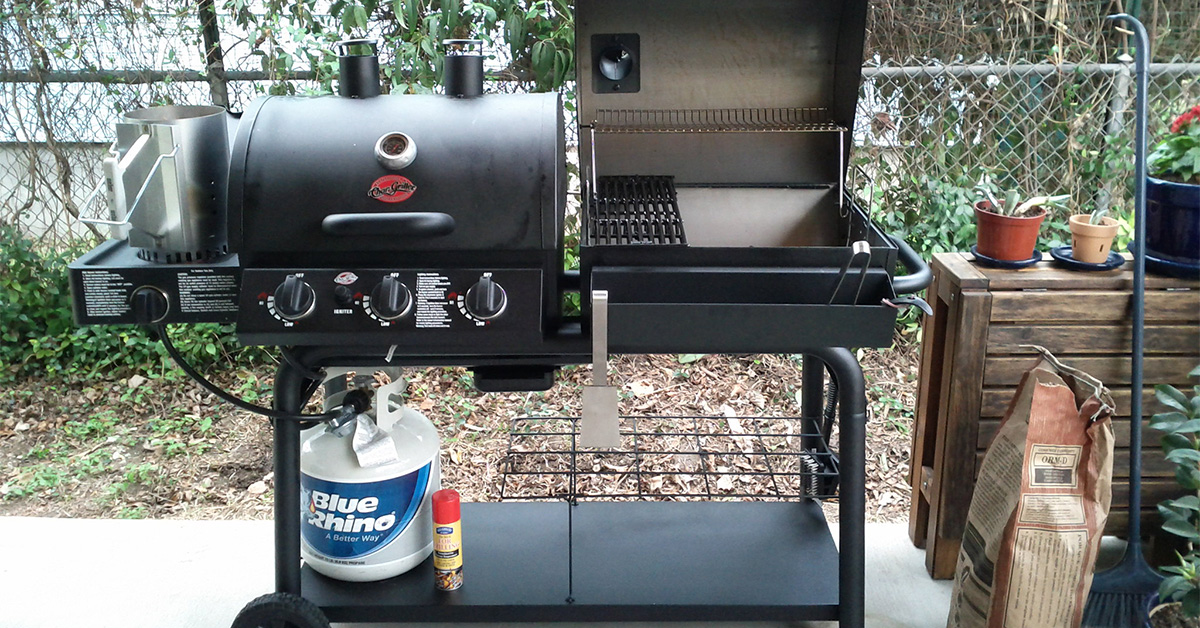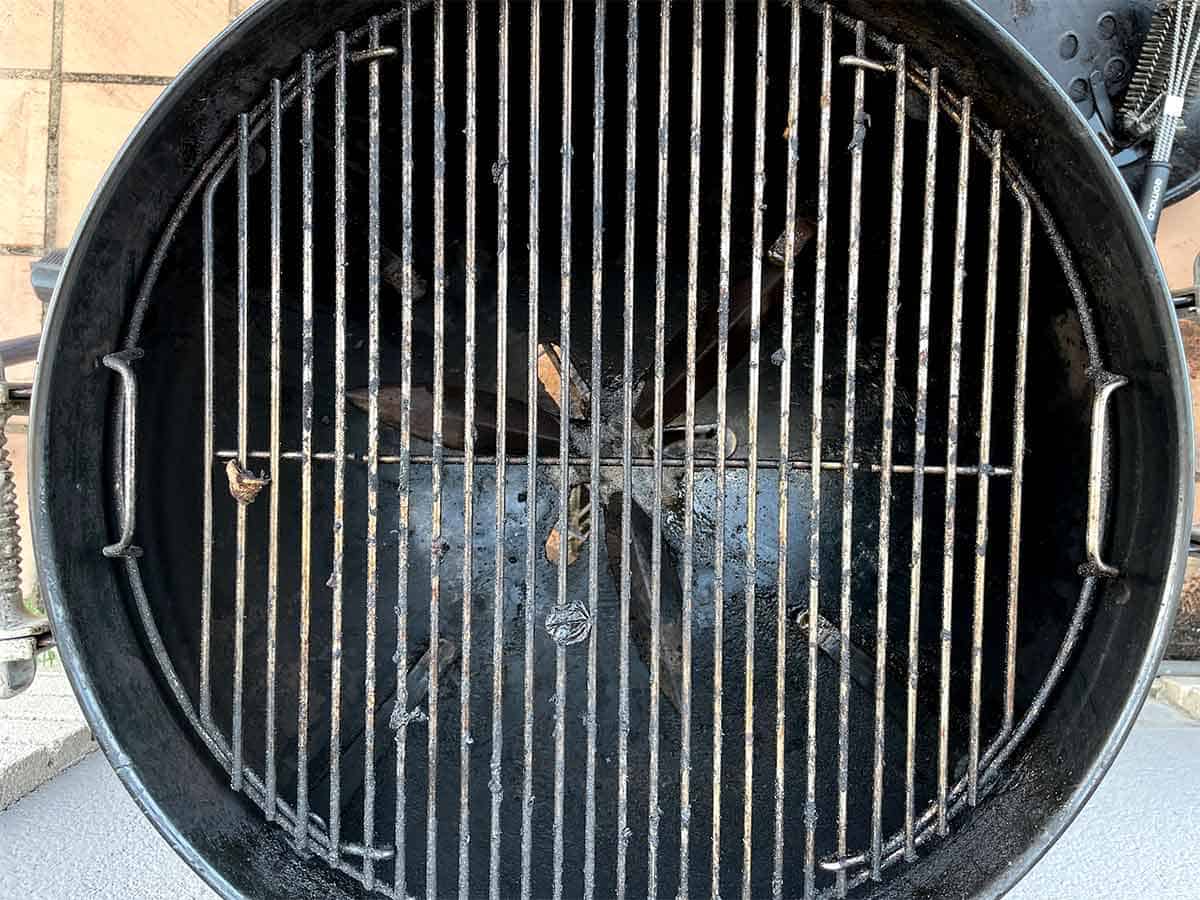The Ultimate Guide to Grilling, Smoking and Barbecuing
If you ask most people what the difference is between grilling, barbecuing and smoking, you’re likely to be told that they’re all the same thing. This is fair enough, in common conversation we pretty much use the three terms interchangeably. However, ask a serious griller and they’ll tell you that each is a distinctly different cooking process, each with its own strengths depending on what food you’re making. In this article, we’ll take a look at what makes each process unique, and what equipment you’ll need to grill, barbecue and smoke.
Guide to Grilling

The first method we’ll take a look at is grilling. Grilling is the easiest and least time-consuming method of the three, so it’s the one we’d recommend beginners try first. It’s time to pull off your grill cover and get cooking. Let’s begin…
What is grilling?
Grilling is a cooking method used all over the world in many different cultures. It has a history dating back 1.8 million years, but really took off in America after the ‘barbecue boom’ in the 1950s. The basic concept has remained the same: cooking food at a high, typically direct heat for a short amount of time. These days, this high heat is typically provided by a charcoal or gas grill.
Cooking your food on a metal grate directly over an open flame, either from gas, charcoals or firewood, results in a rapid heat transfer through radiation. This high heat browns meats rapidly, causing a chemical reaction called the Maillard reaction to take place. This reaction is similar to caramelization, and improves the flavor of the meat while killing off any surface bacteria.
What temperatures are best for grilling?
There are actually two main grilling methods, both with their own temperatures. Grilling with direct heat calls for food to be placed directly on the grate above 350 degrees Fahrenheit or above – steaks and chops, for example, should be around 450 to 500 degrees, to keep cooking times short. Direct heat is perfect for any smaller cuts of meat.
On the other hand, grilling with indirect heat takes advantage of the heat produced, but cooks food away from direct contact. Temperatures are typically between 190 and 300 degrees Fahrenheit, and cooking takes place via convection, usually with the lid open. In a way, indirect heat is similar to oven cooking. It’s perfect for cooking larger cuts with longer cooking times, or for finishing smaller foods like steaks and burgers without burning them. Delicate foods can also benefit from a lower temperature.
How to set up a two-zone fire
You may be wondering, how do I create indirect heat on my grill? With a gas grill it’s easy: simply turn down the burner to low, that is unless you’ve got a small gas grill, which only has one burner and then you won’t be able to do this. With a charcoal grill, the answer is with a two-zone fire. To create a two-zone fire, you’ll just need to load the charcoal on one side of the grill, leaving the other empty. Easy!
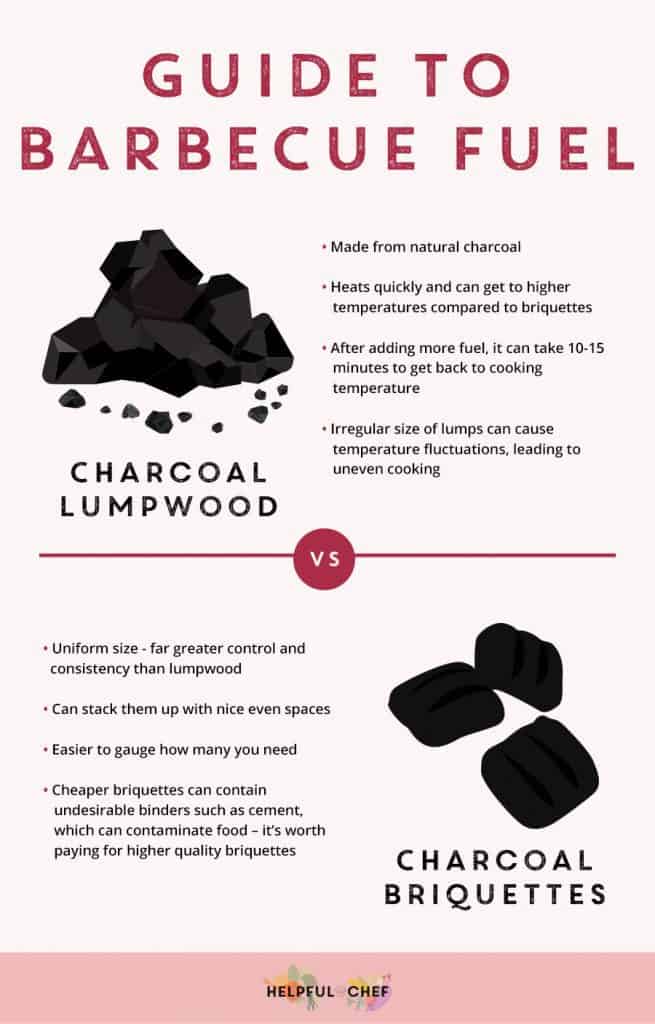
You can use the hot zone to grill over direct heat, and the cooler zone to cook with indirect heat – steaks on one side, veg on the other, for example. The cool zone is also perfect for keeping finished food warm without overcooking it. Finally, the cool zone is useful for controlling flare-ups, which occur when fat drips onto the coals, and can ruin your food. Just move the dripping item over into the cool zone until there’s no more flare-up.
How long does grilling take?
Since it involves such high temperatures, there is no need for prolonged cooking when using direct heat. This means that grilling usually takes under an hour. Compared to barbecuing and smoking, this is pretty fast! Some foods, such as thinner cuts of steaks, can be finished grilling in under ten minutes (but be sure to give them time to rest!).
Of course, grilling with indirect heat will take longer – sometimes up to an hour or over – but can be the best choice for larger cuts of meat to ensure that they cook through.
The Ultimate How to Clean your Grill Guide
What are the best foods to grill?
The best foods to grill are foods that respond well to high-heat cooking. Cuts of meat such as New York, bone-in ribeye, skirt or flank steaks are perfect for grilling, as well as chicken breasts, thighs, wings and drumsticks. Grilling also works well for fish and tender veggies, as well as backyard grilling staples like burgers and hotdogs. Grilling meat like steaks doesn’t require much finesse, but fish, veg and poultry can be a little trickier.
What equipment do I need to grill?
All you need to get grilling is a conventional gas or charcoal grill or griddle (flat top grill). With gas grills it’s a simple case of turning the burner up to a high temperature. For charcoal grills, make sure to leave your coals burning for long enough to get hot and ashy before you start grilling. Start too soon and your food won’t cook properly, and your grill probably won’t be be reaching optimum heat levels. You shouldn’t forget to clean your grill in between uses too.

Guide to Barbecuing
Next, let’s take a closer look at barbecuing. A step up from grilling, barbecuing is a bit more involved, but the results are well worth it.
What is barbecuing?
In the Northern parts of the US, you might hear the word ‘barbecue’ to describe anything cooked on a grill, from hot dogs to burgers, and slathered in delicious sauce. But barbecuing is actually a cooking method in itself, and the South has been the barbecue capital of America for a long time. Each region has specific types of barbecue, but the central concept is the same: ‘low and slow’. The purpose of this style of cooking is to transform large, tough cuts of meat into tender, fall-off-the-bone deliciousness. Let’s take a look at how!
What temperatures are best for barbecuing?
The ‘low’ in ‘low and slow’ refers to cooking temperature. In practical terms, this means that temperatures are generally around 200 to 250 degrees Fahrenheit – so much lower than grilling. This can change depending on what meat you’re barbecuing, and how long for.
How long does barbecuing take?
By now you’ve probably worked out that the ‘slow’ in ‘low and slow’ refers to a more time-consuming cooking process. As you’re using low, indirect heat, cooking times are higher – generally 2 hours or more, and in some cases as long as 18 hours!
As well as allowing the heat to circulate to bring the meat up to temperature, this longer cooking time actually enables the meat’s tough connective tissues such as collagen to break down and dissolve. Collagen starts to break down into smooth gelatin at about 150 to 170 degrees Fahrenheit, but can take hours to break down fully, so giving it plenty of time to heat helps make for a succulent and tender bite.
What are the best foods to barbecue?
You can barbecue pretty much any type of meat, but where the barbecue truly shines is with larger, tougher cuts of meat – we’re talking whole pork shoulders, beef briskets, racks of ribs, whole turkeys. The slow cooking times help to enhance the tenderness of the cuts, turning toughness into something that melts in the mouth.
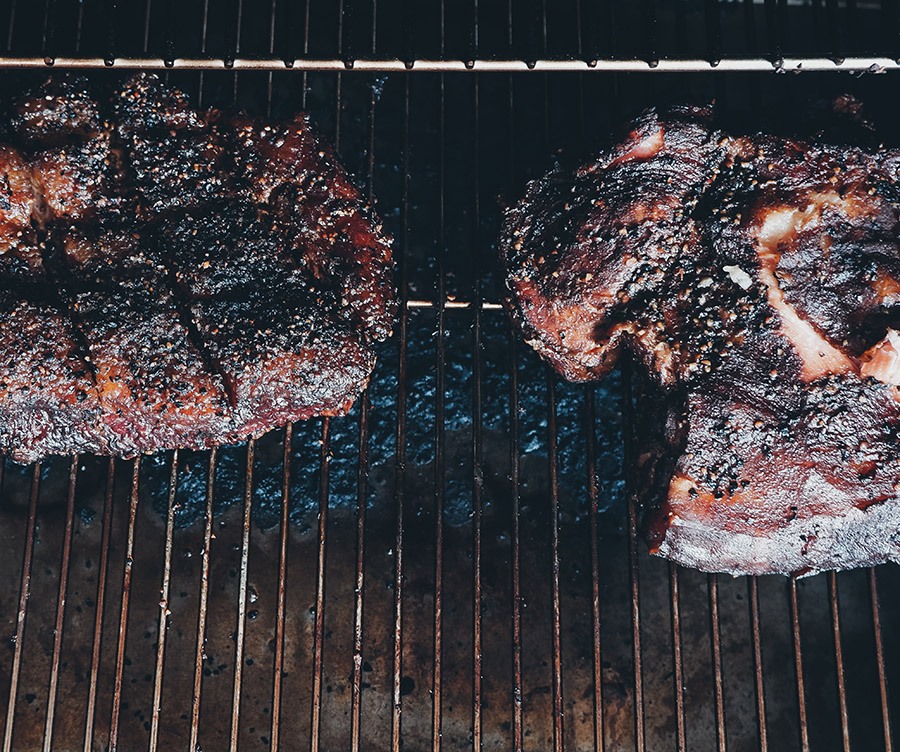
Look for visibly fatty cuts with good marbling: the fat will melt and create a super juicy result, and the marbling indicates that the fat is well-distributed throughout the muscle, ensuring that your finished product will be tender throughout.
What equipment do I need to barbecue?
Just like grilling, you can barbecue on conventional charcoal or gas barbecues. For gas grills, just turn the burners down to a low heat. Charcoal grills will need fresh coals every hour or so –use the little doors to help you add more without disturbing the meat. For both grills, you’ll also need to replace any wood chips you’re using for additional smoky flavor. You’ll want to try and keep the heat as consistent as possible for best results.
The Helpful Chef Guide to BBQ Fuel
Guide to Smoking
Finally, let’s talk about smoking. This final technique requires a bit more flair – it’s more of an art than a science, according to pitmasters – but we’d definitely recommend giving it a go once you’re comfortable with grilling and barbecuing.
What is smoking?
Smoking is the process of exposing food to an aromatic smoke, typically from hickory, mesquite, oak, maple, or applewood, in order to flavor, preserve, and brown the food. By placing food inside a chamber that traps smoke, the food actually cooks from all angles via convection from the low, indirect heat. Smoking will not dry out your food, and as you don’t need to adjust the meat while its cooking, the result is moist and succulent, falling off the bone more readily than barbecued or grilled meats.
Oftentimes, you’ll be smoking larger, high quality meats, which might be more expensive than the meats you normally cook with. Think of it as an investment: smoking can really help you to bring out the best in these cuts.
What temperatures are best for smoking?
Smoking typically occurs at even lower temperatures than a barbecue – usually below 250 degrees Fahrenheit, but can be anywhere between 90 to 300 degrees. Be careful: if the temperature is too high, the meat will cook too quickly, and the smoke will not be able to penetrate it, resulting in no smoky flavor. You will also need to ensure that your external heat source is kept attached and at a constant temperature, to ensure a consistent smoke.
There are three main methods of smoking. Regular low ‘n’ slow smoking is typically under 250 degrees Fahrenheit. In most cases, you’ll be smoking for several hours.
Smoke roasting tends to be at 275 degrees and over, and is similar to oven roasting, but adds smokiness to the flavor profile. This method is faster, so there is less chance of leaner cuts drying out.
Finally, cold smoking applies a smoky taste to the foods without heating them, and as well as enhancing flavor, this can help with preserving. This makes cold smoking perfect for adding depth to precooked meats, cheese or nuts, although it takes skill and preparation to cold-smoke raw meat. At temperatures of 90 degrees and below, cold smoking can be dangerous for many types of meat too, as the temperature is low enough to be bacteria friendly. Also, be aware that in some cases, you might need to invest in an add-on cold smoke generator.
The Helpful Chef Guide the Best Foods to Smoke?
How long does smoking take?
Smoking is the most time-consuming method of the three, with smoke times checking in at an average of five to six hours. Sometimes you can be going for 24 hours or more, or up to two weeks in some cases!
It’s worth mentioning that you don’t need to be at the smoker the whole time – you can relax and take it easy, just try and check on the smoker every 45 minutes to an hour if possible, replenishing the BBQ fuel if necessary.
What are the best foods to smoke?
So many foods are perfect for smoking, from ribs to shoulders, butts to briskets, whole poultry to ham, salmon or even roasts. Since smoking is another slow cooking method, it’s ideal for tougher, fattier cuts of meat with lots of connective tissue. Just like barbecuing, the collagen in the connective tissue will melt into gelatin, and the fats will render into the meat, making it exceptionally tender. The addition of a smoky flavor makes for a truly mouth-watering combination.
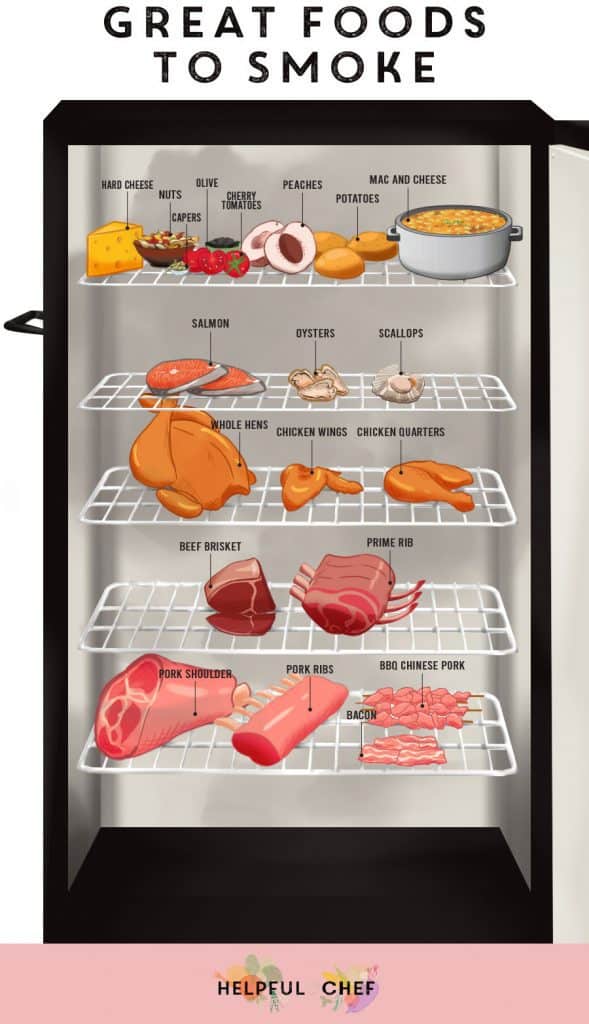
What equipment do I need to smoke?
You can actually get a great smoke using a conventional gas or charcoal grill. A gas grill with a smoke box will impart a pleasantly smoky flavor, and with a charcoal barbecue, you’ll need to close the lid to keep the smoke in. There are fuel combo grills available too, however, which offer added versatility.
However, if you’re looking to get into serious smoking, it could be worth investing in a dedicated smoker. There are a range of different types, suited to all skill levels and budgets.
Either way, you’ll be needing some sort of wood to impart that characteristic smoky flavor on your food. There’s a wide range of woods you can use, that each have their own unique flavor. Beware that some woods, such as mesquite, can be very strong, which could put off some guests. Also, make sure you don’t just chuck any old wood in your smoker – sap tree woods such as pine can actually ruin your food, and are slighty poisonous – stick to hard woods! If you want some more advice about smoking, we’ve got you covered.

Things to consider
So, what should you start with? Ask yourself the following questions to decide which cooking method is most suitable for you right now on your grilling journey.
What do you want to cook?
The main question to ask yourself is, what do you want to cook? In many cases, the most satisfying foods turn out to be the simplest. If its burgers, steaks, chops, sausages or hot dogs you’re looking for, perhaps you should consider a grill first. On the other hand, if your mind is set on shoulders, butts, briskets and ribs, a barbecue might be more suited to your needs. If you’re already familiar with grilling and barbecuing, it could be time to take things to the next level and start smoking.
Remember that although you’ll get better and more consistent results with a dedicated smoker, for the more casual enthusiast you can still achieve a decent smoke on a conventional gas or charcoal grill. It’s also worth seeing what additional features or attachments are available for your current grill, as this could help you to explore other cooking methods at a lower cost.
How much time do you have to cook?
In a perfect world, we’d all have the time and patience to barbecue or smoke massive cuts of meat whenever we fancied. In reality though, barbecuing and smoking do take a lot of time and effort, with many barbecues and smokers requiring regular attention involving adding wood, checking temperatures and adjusting vents to allow for airflow. As queen of the pit Tootsie Tomanetz says, ‘There is no ‘set it and forget it’ setting in cooking good BBQ’. On the other hand, you can sort the perfect steak with a grill in as little as ten minutes! Before investing in a smoker, ask yourself if you’re sure you have the time and patience to make the most of it.
How to Keep Your Options Open
If you’re thinking about getting into smoking more seriously, but aren’t sure about investing in a proper smoker just yet, you could always consider a combination grill. This is a type of barbecue that can both grill and smoke.
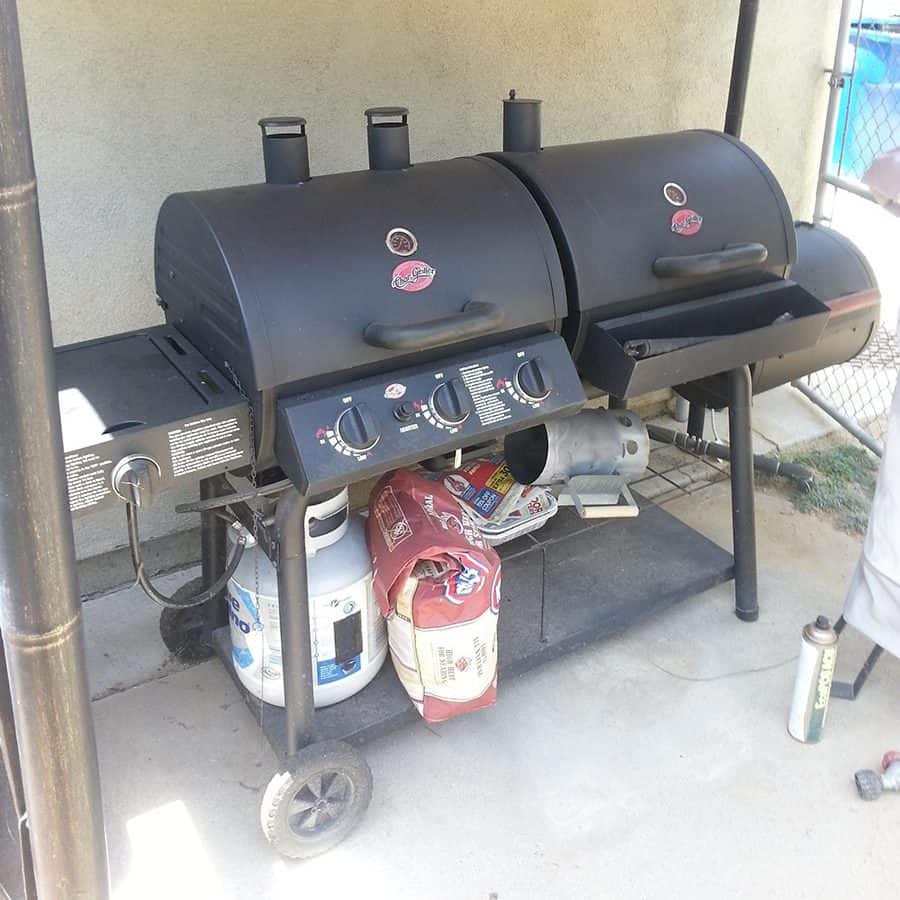
For example, some ceramic kamado-style grills are extremely well insulated, to the point that they are capable of smoking with ease at low temperatures, but can still get extremely hot to facilitate grilling too. The price tag can be a bit higher, but if you’re looking for true versatility, a kamado grill could definitely be worth considering.
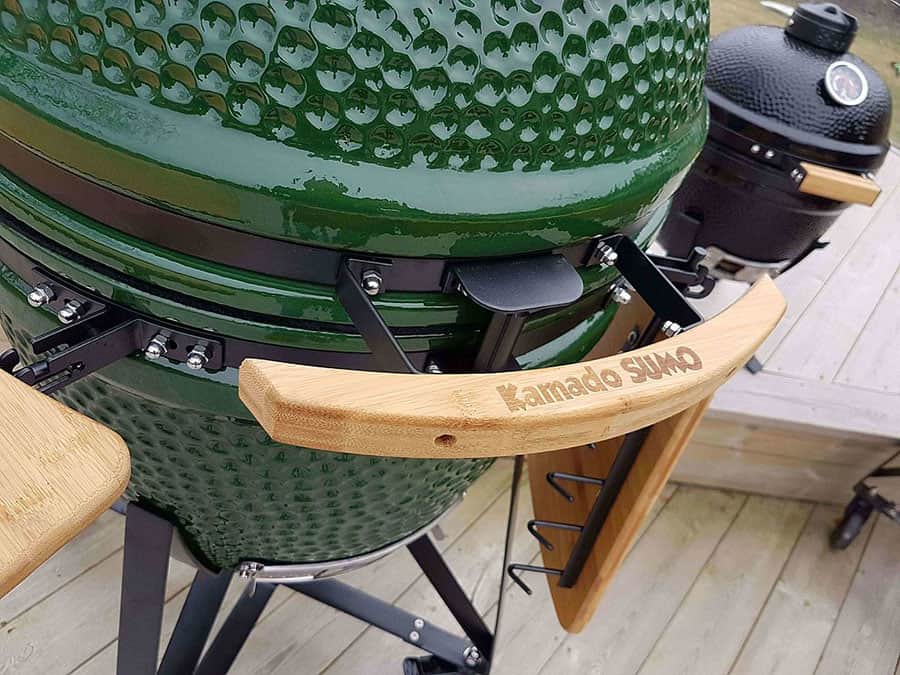
For a more niche piece of equipment, you could also check out pellet smokers. Some are more than capable of cranking up the heat, for grilling food. Be aware that as they cook via indirect heat, most pellet grills aren’t capable of searing your food. If this sounds like a deal breaker for you, don’t worry – some units do have searing zones just over the firepot.
Summary
So now you know all about grilling, barbecuing and smoking. We hope this guide has cleared up what makes these processes unique and helped you to decide which method you want to try first. And the next time someone asks you the difference, you’ll be able to answer like a true pitmaster!
FAQs
Q: How do I know when my food is done grilling/barbecuing/smoking?
A: For all foods, its essential to check their internal temperature. This is the only way to accurately check if your food is safe to eat. Therefore, we’d highly recommend that you invest in a dedicated food thermometer, which you can stick into your food to take a temperature reading. You can then check against this list of internal food temperatures.
Q: I’m new to grilling but I’m excited to try food with a smoky flavor. How can I experiment with these flavors?
A: You might want to check out liquid smoke. This highly concentrated liquid can be rubbed on your meat – it’s so strong that you’ll only need a few drops!
If you’re looking for something a little more advanced, you could also have a look at smoking guns. These devices are filled with wood chips of your choice, and allow you to impart a smoky flavor on cooked foods in as little as five minutes – far faster than cooking the food entirely via smoking.
If you already own a regular gas or charcoal grill, you’ll be pleased to hear that you can also smoke on a conventional grill using a container of wood chips.
Q: I can’t decide which wood to use when smoking. Any recommendations?
A: The general rule of thumb is as follows: maple, alder or pecan are good starter woods, which offer a mild and sweet smoke; fruit woods (such as apple or cherry) are mild and sweet, with additional fruity notes. If you’re after a more powerful smokiness, you might like to try mesquite or hickory.
Also, be aware that you can increase or decrease the amount of chips you use, or combine different woods, to create different flavors and intensities.
References
Peter P. Purslow (31 March 2018), ‘Contribution of collagen and connective tissue to cooked meat toughness; some paradigms reviewed’. Accessed at: https://pubmed.ncbi.nlm.nih.gov/29636208/.
Daniel Vaughn (3 February 2016), ‘The Science of the Smoke Ring’. Accessed at: https://www.texasmonthly.com/bbq/the-science-of-the-smoke-ring/.
Kamado Jim (20 September 2014), ‘An Abbreviated History of the Kamado Grill’. Accessed at: http://kamadojim.com/an-abbreviated-history-of-the-kamado-grill/.
Matt Kirouac (date unknown), ‘Chicken Trends: Dark Over White’. Accessed at: https://www.usfoods.com/great-food/food-trends/dark-meat-lights-up-restaurant-dining-trends.html.
Emma Christensen (4 April 2008), ‘Food Science: why you should rest meat after cooking’. Accessed at: https://www.thekitchn.com/food-science-resting-meat-46678.
Dan Gentile (7 March 2017), ‘14 Easy Ways to Improve Your Grilling, According to BBQ Experts’. Accessed at: https://www.thrillist.com/eat/nation/grillist-bbq-pitmaster-grilling-advice.
Dan Gentile (7 March 2017), ‘14 Easy Ways to Improve Your Grilling, According to BBQ Experts’. Accessed at: https://www.thrillist.com/eat/nation/grillist-bbq-pitmaster-grilling-advice.
Jonathan Maes (25 May 2018), ‘What Happens If You Don’t Clean Your Grill?’. Accessed at: https://www.progrillcleaning.com/blog/what-happens-if-you-dont-clean-your-grill/.
Ann Garrison (date unknown), ‘Burner Tubes – Time to Replace? Maybe Not!’. Accessed at: https://www.weber.com/US/en/blog/burning-questions/burner-tubes-time-to-replace-maybe-not/weber-30077.html.
Organic Consumers Association (date unknown), How Toxic Are Your Household Cleaning Supplies? Accessed at: https://www.organicconsumers.org/news/how-toxic-are-your-household-cleaning-supplies.
CDC (21 June 2019), ‘Sodium Hydroxide’. Accessed at: https://www.cdc.gov/niosh/topics/sodium-hydroxide/default.html.
Monroe Engineering (24 October 2019), ‘Why Iron Rusts (And How to Prevent It)’. Accessed at: https://monroeengineering.com/blog/why-iron-rusts-and-how-to-prevent-it/.
Lisa Freedman (23 June 2017), ‘The Creepy Reason Your Gas Grill May Be Getting Hard to Light’. Accessed at: https://www.thekitchn.com/the-creepy-reason-your-gas-grill-may-be-getting-hard-to-light-245106.
Evan J Harlor, Timothy L Lindemann, Thomas L Kennedy (2 July 2012), ‘Outdoor grilling hazard: wire bristle esophageal foreign body–a report of six cases’. Accessed at: https://pubmed.ncbi.nlm.nih.gov/22752993/.
The Maids (30 July 2020), ‘The Do’s and Don’ts for Cleaning Stainless Steel’. Accessed at: https://www.maids.com/blog/cleaning-stainless-steel/.
MD Anderson Cancer Center (9 June 2011), ‘Keep Cancer off the BBQ Grill’. Accessed at: https://www.mdanderson.org/newsroom/does-eating-meat-cause-cancer—meat–cancer.h00-158672634.html.
Medium (4 August 2017), ‘The Wood To Charcoal Carbonization Process’. Accessed at: https://medium.com/@robinchen7887/the-wood-to-charcoal-carbonization-process-188f0693baf5
Planet Green (6 December 2017), ‘Charcoal Vs. Gas Grill: Which Is Better For The Environment?’. Accessed at: https://www.huffpost.com/entry/charcoal-vs-gas-grill-whi_n_109524.
Loretta Hall (date unknown), ‘Charcoal Briquette’. Accessed at: http://www.madehow.com/Volume-4/Charcoal-Briquette.html.
MET Group (27 July 2020), ‘What is the Difference Between Natural Gas and Propane?’. Accessed at: https://group.met.com/energy-insight/difference-between-natural-gas-and-propane/9.
BC Cook Articulation Committee (8 September 2015), ‘Composition of Meat’. Accessed at: https://opentextbc.ca/meatcutting/chapter/composition-of-meat/.
Joni Sweet (7 July 2018), ‘Is Grilling Bad For Your Health? Here’s What A Registered Dietitian And Oncology Specialist Wants You To Know’. Accessed at: https://www.healthyway.com/content/is-grilling-bad-for-your-health/.
USDA (11 May 2020), ‘Safe Minimum Internal Temperature Chart’. Accessed at: https://www.fsis.usda.gov/food-safety/safe-food-handling-and-preparation/food-safety-basics/safe-temperature-chart.
Nick Follows (31 July 2018), ‘Using a BBQ Thermometer for Safe Meat Preparation’. Accessed at: https://www.comarkinstruments.net/news/bbq-thermometer-safe-meat-preparation/.
Earth Talk (28 July 2019), ‘The Health and Pollution Risks of Charcoal Grilling’. Accessed at: https://www.thoughtco.com/backyard-barbecues-bad-for-your-health-1203996.

